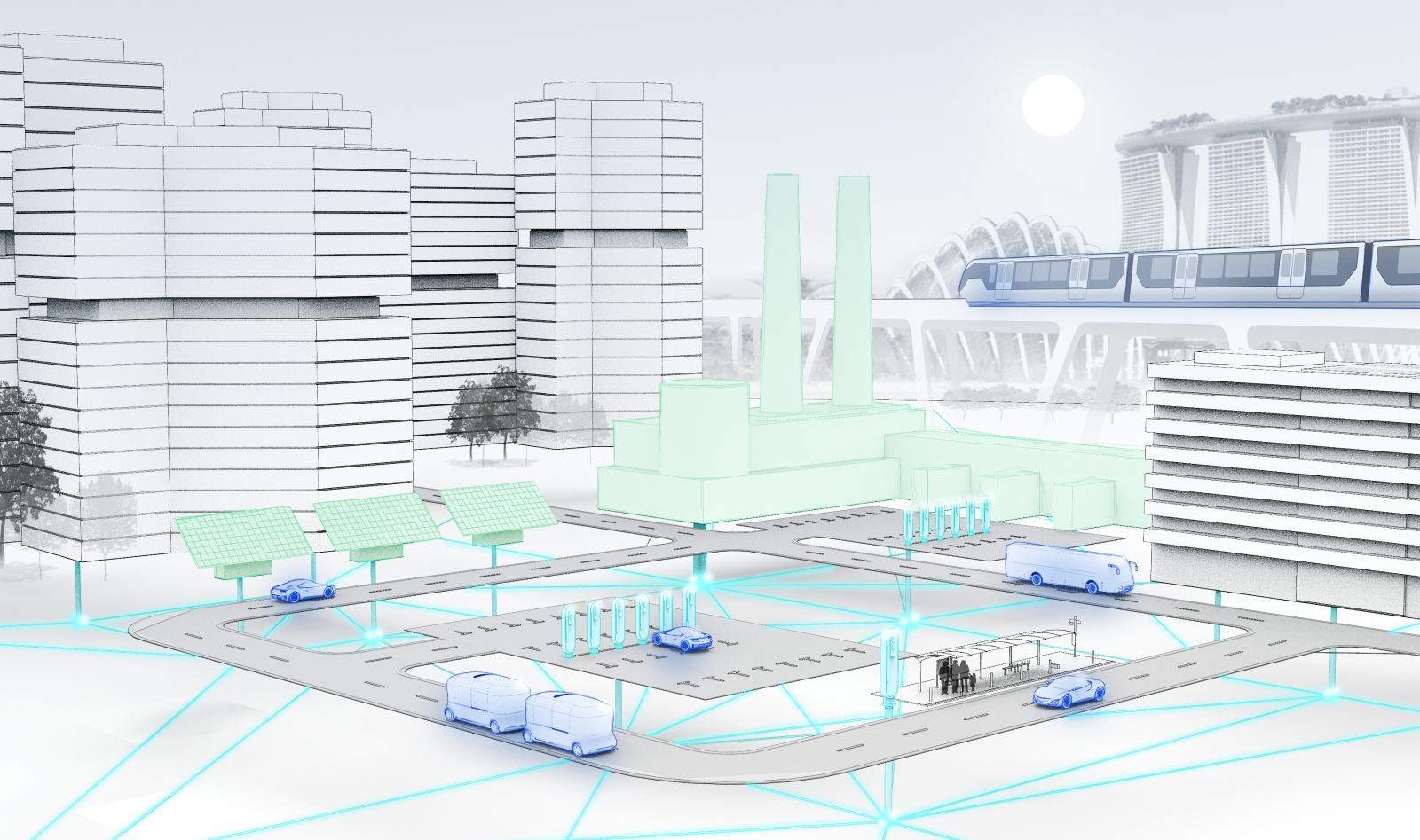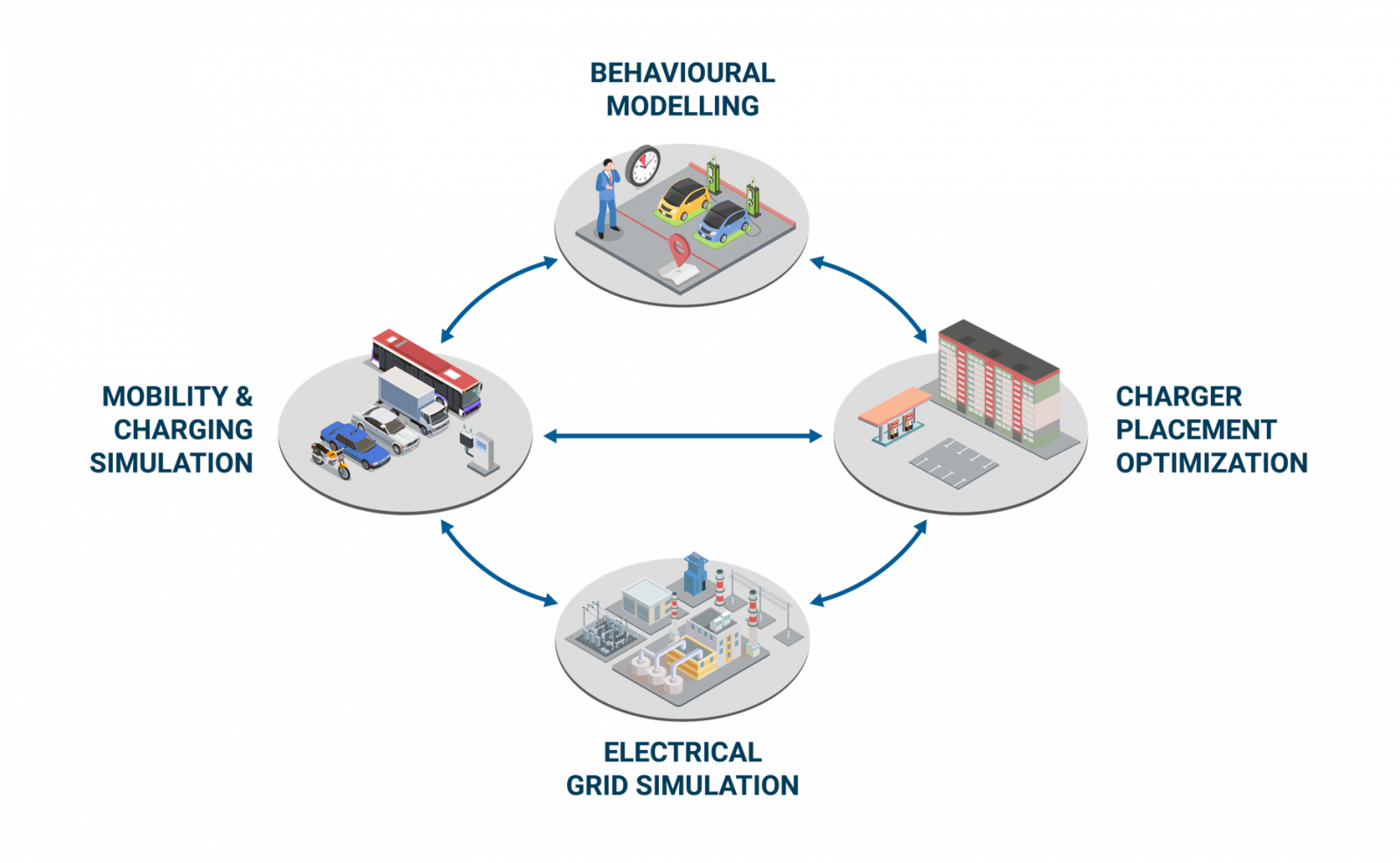- AquaCycle
- Proteins4Singapore
- Singapore's Pathway to Carbon Neutrality
- CellFACE
- LightSPAN
- Computational Modelling Group
- Energy and Power Systems Group
- SITEM - Singapore Integrated Transport and Energy Model
- MoVES (Mobility in Vehicular Environments at Scale) lab
- Projects
SITEM - Singapore Integrated Transport and Energy Model

A*STAR’s Institute of High Performance Computing (IHPC) and TUMCREATE Ltd (TUMCREATE) are working together on a research project that supports Singapore’s planning for the transition to electric vehicles (EVs) nationwide. The Singapore Integrated Transport Energy Model (SITEM) will be used to conduct a comprehensive analysis of projected electric vehicle (EV) charging patterns and energy demand, which will support policymaking on Singapore’s budget 2040 vision for all vehicles to run on cleaner energy and contribute towards Singapore’s decarbonisation commitments. The research project is commissioned by the Science and Technology Policy and Plans Office (S&TPPO), Prime Minister’s Office, and aims to advance the nation’s capabilities in integrated modelling and simulation of transport and power systems.
Singapore’s 2040 vision to phase out internal combustion engine (ICE) vehicles and have all vehicles run on cleaner energy will involve a large-scale, multi-agency effort to provide charging infrastructure, electrify public vehicles, and upgrade the electrical grid to accommodate the new demand. Designed to support this effort, SITEM is the first high-fidelity, island-wide simulation of EV transport in Singapore that integrates multiple aspects of mobility and energy modelling, including the movements of individual vehicles, drivers’ decisions about where and when to charge, and the interaction of EV charging demand with electricity grid capacity. Through advanced scenario modelling and simulation, the project aims to deliver insights on how Singapore can optimise EV charging stations’ placement to address drivers’ charging needs and to efficiently allocate energy demand and upgrades across the power grid. Robust modelling and simulation has potential to reap significant cost avoidance, as projects in the infrastructure and energy space are typically costly and hard to re-work once in the implementation stage.
To model such a large-scale and multi-layered system at high resolution, IHPC and TUMCREATE are employing advanced capabilities including large scale complex systems modelling and optimisation, high performance and distributed computing, advanced data analytics and empirically grounded agent-based modelling of human behaviour. The project team also draw on extensive experience in past and ongoing project collaborations with various local entities in the transport ecosystem, including transit operators, regulatory bodies and urban planners.
The SITEM project builds on two primary simulation technologies developed by TUMCREATE in Singapore under its NRF-funded Mobility Programme:
- City Mobility Simulator (CityMoS) utilises high-performance computing techniques to enable high-detail transport simulation of the entire island of Singapore, while maintaining short turnaround times. .
- Multi Energy System Modelling & Optimisation (MESMO) is an advanced software framework that combines simulation of electrical grids and optimisation techniques to mitigate the grid impact of distributed energy resources (such as photovoltaics) and new types of loads (such as EV charging).
Network data and modelling considerations were provided by the Energy Market Authority and national grid operator SP Group.

While further development of SITEM is ongoing, preliminary findings from simulation studies conducted by the IHPC and TUMCREATE research team have enabled collaborating government agencies and industry partners to validate and refine their planning assumptions regarding such questions as the adequacy of electric charger provisioning to meet projected demand and the sufficiency of electrical grid capacity to support vehicle electrification requirements.
In addition, SITEM’s advanced scenario modelling capabilities have enabled regulatory agencies to explore and evaluate varied pathways to vehicle electrification. For example, in light of the fact that private electric cars will generally park longer than the actual duration required for the car to charge fully, smart charge management can help to reduce grid infrastructure upgrade costs without compromising the overall energy provisioned to the electric cars. SITEM makes it possible to estimate the efficiency gains from such systems, and can model their impact alongside or in combination with other mechanisms such as incentive-based demand shifting, smart scheduling and local energy storage.
Dr Lim Keng Hui, Executive Director of A*STAR’s IHPC, said “The beauty of simulation and modelling in urban planning is that we can integrate with multiple real-world datasets to create realistic computational models of our city, and explore different designs to achieve the optimal outcomes before physical infrastructure upgrade is commissioned. Our aim is for this collaboration to allow local government agencies to tap on A*STAR’s advanced systems modelling and simulation capabilities to better plan and support the electrification effort in Singapore. IHPC has years of expertise in land transportation research, and we look forward to this collaboration with TUMCREATE to undertake this national-level strategic modelling project.”
Prof Ulf Schlichtmann, CEO of TUMCREATE, said, “It is with great pleasure that TUMCREATE is part of this exciting multi-stakeholder project, together with our partner IHPC and the various Singapore government agencies. I am delighted to see that our simulators, CityMoS and MESMO, play an important role in providing recommendations for the electrification of Singapore’s transport system. Since its establishment, TUMCREATE has been conducting innovative research in support of Singapore’s sustainability goals and this is a great opportunity for us to contribute further on and show the relevance of our technologies.”
Er Pang Chung Khiang, Group Chief Systems Officer of S&TPPO, PMO, said, “This collaboration between the research teams and relevant government agencies allows for integration of the best from two research institutes to address national level challenges. The coupled transport and energy simulation model allow for continuous refinement of planning parameters to better understand interdependencies and emergent behaviours with new concept of operations for decision making. Modelling and simulation generate insights that brings downstream savings on infrastructure upgrades whilst allowing our agencies to focus efforts to enhance overall commuter satisfaction. These efforts dovetail with developments like our Smart Nation Initiative.”

